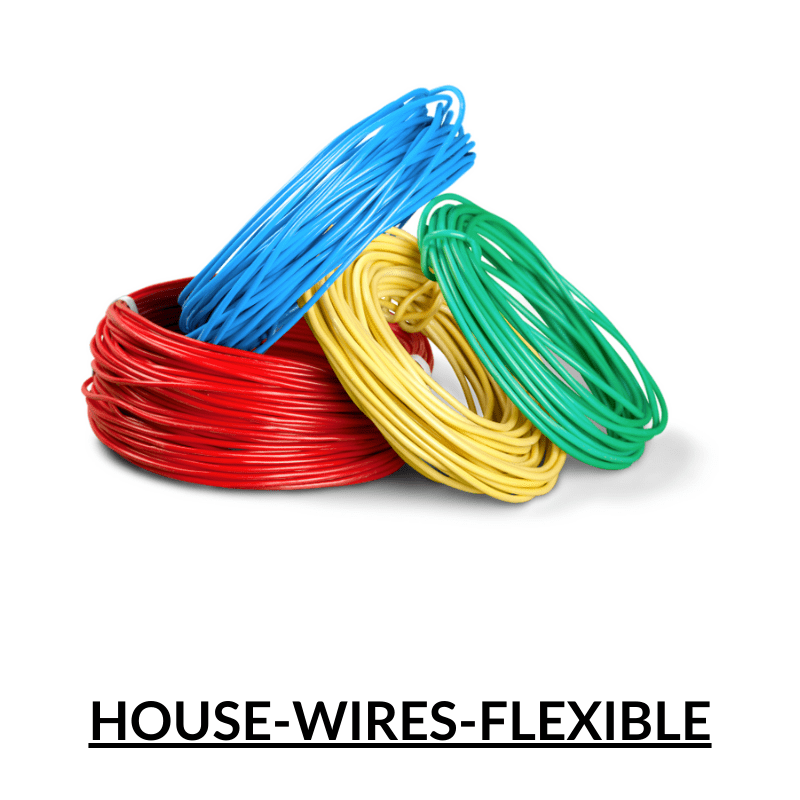House-wires-flexible
House wires and flexibles are types of electrical wires that are commonly used for wiring residential homes and buildings. They are used to carry electrical power from the main electrical panel to various electrical devices and appliances throughout the building.



- Conductor material: House wire cables are typically made of copper or aluminum, which are highly conductive materials that can carry electrical current efficiently.
- Insulation material: The insulation material used in house wire cables is typically made of PVC (Polyvinyl Chloride), which is a durable and flexible material that provides electrical insulation and protection against moisture and abrasion.
- Size: House wire cables are available in a variety of sizes, typically measured in American Wire Gauge (AWG), which refers to the diameter of the wire. The size of the wire used in a building’s electrical system depends on the electrical load requirements and the distance between the electrical panel and the device being powered.
- Color coding: House wire cables are color-coded to indicate their intended use and voltage rating. For example, black wires are typically used for hot wires, white or gray wires are used for neutral wires, and green or bare copper wires are used for ground wires.
- Voltage rating: House wire cables are available in different voltage ratings, depending on the electrical load requirements of the building. Typical voltage ratings include 120 volts, 240 volts, and 480 volts.
- Power distribution: House wire cables are used to distribute electrical power from the main electrical panel to various electrical devices and appliances throughout the building.
- Lighting: House wire cables are used to power lighting fixtures and switches in the building.
- Heating and cooling: House wire cables are used to power heating and cooling systems in the building, such as air conditioners.
- Hot conductor: This conductor carries the electrical current from the power source to the electrical devices in your home. In a standard AC electrical system, the hot conductor is usually black or red.
- Neutral conductor: This conductor completes the electrical circuit and carries the electrical current back to the power source. In a standard AC electrical system, the neutral conductor is usually white or gray.
- Ground conductor: This conductor provides a safe path for electrical current to flow to the ground in the event of a fault or electrical surge. In a standard AC electrical system, the ground conductor is usually bare or green.
PVC (Polyvinyl Chloride): This is one of the most commonly used insulation materials for house wire cables. PVC is a cost-effective material that provides good resistance to moisture, heat, and chemicals.
XLPE (Cross-Linked Polyethylene): This is a type of insulation material that provides excellent resistance to heat, moisture, and chemicals. XLPE insulated cables are commonly used in applications that require higher temperature resistance.
Explore Our Copper Products
Explore Our Wire & Cables
House-wires-flexible
House wires and flexibles are types of electrical wires that are commonly used for wiring residential homes and buildings. They are used to carry electrical power from the main electrical panel to various electrical devices and appliances throughout the building.
Features
- Conductor material: House wire cables are typically made of copper or aluminum, which are highly conductive materials that can carry electrical current efficiently.
- Insulation material: The insulation material used in house wire cables is typically made of PVC (Polyvinyl Chloride), which is a durable and flexible material that provides electrical insulation and protection against moisture and abrasion.
- Size: House wire cables are available in a variety of sizes, typically measured in American Wire Gauge (AWG), which refers to the diameter of the wire. The size of the wire used in a building’s electrical system depends on the electrical load requirements and the distance between the electrical panel and the device being powered.
- Color coding: House wire cables are color-coded to indicate their intended use and voltage rating. For example, black wires are typically used for hot wires, white or gray wires are used for neutral wires, and green or bare copper wires are used for ground wires.
- Voltage rating: House wire cables are available in different voltage ratings, depending on the electrical load requirements of the building. Typical voltage ratings include 120 volts, 240 volts, and 480 volts.
Applications
- Power distribution: House wire cables are used to distribute electrical power from the main electrical panel to various electrical devices and appliances throughout the building.
- Lighting: House wire cables are used to power lighting fixtures and switches in the building.
- Heating and cooling: House wire cables are used to power heating and cooling systems in the building, such as air conditioners.
Conductors
- Hot conductor: This conductor carries the electrical current from the power source to the electrical devices in your home. In a standard AC electrical system, the hot conductor is usually black or red.
- Neutral conductor: This conductor completes the electrical circuit and carries the electrical current back to the power source. In a standard AC electrical system, the neutral conductor is usually white or gray.
- Ground conductor: This conductor provides a safe path for electrical current to flow to the ground in the event of a fault or electrical surge. In a standard AC electrical system, the ground conductor is usually bare or green.
Insulated
XLPE (Cross-Linked Polyethylene): This is a type of insulation material that provides excellent resistance to heat, moisture, and chemicals. XLPE insulated cables are commonly used in applications that require higher temperature resistance.


















